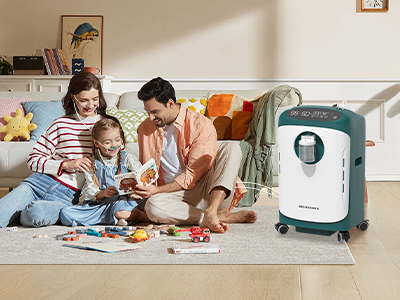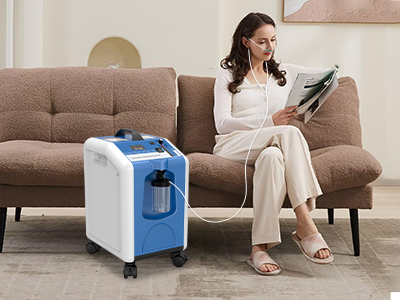18 Apr 2025
In the realm of respiratory care, home oxygen therapy is no longer just a life-saving intervention—it’s a life-enhancing one. Far beyond keeping patients afloat, it empowers them to reclaim vitality, independence, and a sense of control. This modality, once confined to hospital walls, now flourishes in living rooms and bedrooms, quietly fueling recovery and resilience.
As chronic respiratory conditions surge globally, home oxygen therapy is becoming a cornerstone of care. It bridges the gap between clinical necessity and everyday wellness, offering patients not just the breath of life—but the breath of possibility.

Understanding Home Oxygen Therapy
At its core, home oxygen therapy is the controlled delivery of supplemental oxygen to individuals with low blood oxygen levels—often due to chronic obstructive pulmonary disease (COPD), pulmonary fibrosis, or heart failure. It compensates for impaired gas exchange in the lungs, ensuring the body receives the oxygen it desperately needs.
The typical arsenal includes oxygen concentrators that purify ambient air, compressed gas cylinders, or liquid oxygen tanks. These are paired with delivery systems like nasal cannulas or masks, tailored to each patient's comfort and lifestyle. It's a symphony of technology designed to normalize oxygen saturation and optimize physiological balance.
Enhancing Daily Functionality and Energy Levels
Oxygen is the spark of cellular combustion. Without it, every process—from digestion to cognition—slows into a sluggish crawl. For patients with chronic hypoxemia, the daily struggle is real: fatigue, brain fog, and shortness of breath become constant companions.
Supplemental oxygen reverses this tide. By boosting oxygen availability in the bloodstream, it enhances mitochondrial function, restores metabolic efficiency, and reduces the work of breathing. The result? Patients can walk further, cook a meal, or climb stairs—without feeling like they just ran a marathon underwater.
Improving Sleep Quality and Reducing Nocturnal Hypoxemia
Nighttime poses a unique challenge for oxygen-compromised patients. During sleep, respiratory drive naturally decreases. For those with compromised lungs, this can result in nocturnal hypoxemia—dangerously low oxygen levels that sabotage rest and recovery.
Home oxygen therapy, especially when integrated with devices like CPAPs or BiPAPs for sleep apnea, stabilizes oxygen saturation throughout the night. This leads to deeper sleep, fewer awakenings, and improved morning alertness. It’s not just about breathing better—it’s about dreaming again.
Psychological and Emotional Benefits
There’s a profound psychological weight that comes with chronic breathlessness. Anxiety, depression, and feelings of helplessness often shadow those with respiratory illness. The fear of not catching one’s breath can shrink a person’s world to the size of their living room.
Oxygen therapy provides not only physical relief but emotional liberation. Breathing becomes less labored, panic attacks subside, and the horizon expands. Patients report feeling more in control, more hopeful, and more like themselves. With every unlabored inhale, confidence returns.

Reducing Hospital Readmissions and Medical Complications
Frequent hospital visits are more than just inconvenient—they’re indicative of unstable health. Exacerbations of COPD or heart failure often stem from insufficient oxygenation. These flare-ups can be life-threatening and expensive.
Home oxygen therapy acts as a preventive force field. Consistent usage reduces the likelihood of acute episodes, cuts down on emergency room visits, and shortens hospital stays. It provides a steady-state of support that allows for smoother sailing, even in turbulent conditions.
Supporting Mobility and Physical Rehabilitation
Mobility is freedom. But for many patients with oxygen needs, movement becomes a calculated risk. The fear of desaturation during exertion can lead to a sedentary lifestyle, which only accelerates deconditioning.
Portable oxygen concentrators shatter these limitations. Lightweight, discreet, and battery-powered, they enable walking in the park, shopping, or attending a family function. This mobility not only supports cardiovascular health but also enriches the soul. Rehabilitation becomes feasible, not frightening.
Personalized Oxygen Delivery: Tailoring to Patient Needs
One size never fits all in medicine. Home oxygen therapy is highly customizable, ensuring that each patient receives the exact dosage and delivery method suited to their condition.
Some require continuous flow; others benefit from pulse flow that syncs with their breathing. Flow rates can be adjusted based on activity levels or time of day. This level of precision enhances comfort and maximizes therapeutic impact, eliminating the guesswork in gas exchange.
Integration with Telehealth and Remote Monitoring
Today’s oxygen concentrators are not just machines—they’re data hubs. With the rise of smart health technology, many devices now offer Bluetooth connectivity, oxygen tracking, and remote clinician access.
This digitized layer allows physicians to monitor trends, receive alerts, and adjust settings without requiring a clinic visit. It transforms care from reactive to proactive, making remote management seamless and intelligent. Welcome to the era of precision pulmonology.
Conclusion: A Breath of Possibility
Home oxygen therapy is more than a machine pumping air—it’s an enabler of life’s richness. It restores the capacity to do, to move, to rest, and to hope. In the intricate dance between health and illness, it offers balance, rhythm, and a renewed sense of autonomy.
Keywords: oxygen therapy
Originally published 18 Apr 2025, updated 18 Apr 2025.